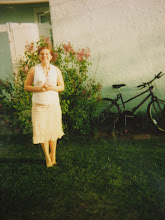
I was so excited to find creamtop whole milk at Whole Foods last week. It's the next best thing to raw milk, which hasn't been in our budget lately but is something that I am determined to start drinking. Creamtop milk is non-homogenized. All that means is that the cream settles at the top of the milk, just like pumped breast milk. It can be scraped off and used in coffee, or it can be used to make butter and whipped cream. Regular homogenized milk, which is what people are probably most familiar with, is processed so that the fat globules are distributed evenly throughout the milk. It is more of an aesthetic thing, really. I am of the opinion that my food should not be tampered with if at all possible. I try (and sometimes fail) to eat things the way God intended and the way my ancestors ate before the invention of pasteurization, homogenization, and fake food (think Twinkies). Milk has fat in it for a reason. The butterfat is what allows the body to absorb the vitamins and minerals. It is also a very important source of preformed vitamin A.
Many people view skim milk as the healthiest form of milk, but this is simply not true. Fat-free, 1%, and 2% milk must be bulked up to get people to buy it. It is fortified with synthetic vitamin D and non-fat dried milk. The dried milk is oxidized cholesterol, which is very bad for your heart. Also, the lactose (sugar) in milk needs the fat to keep insulin levels from shooting up.
L.M. Montgomery, who wrote the "Anne of Green Gables" series, mentions cream and milk often. Cream was given to the weakest child in order to nourish and strengthen the sick child. There was also a "mean" character who was known for feeding her children skim milk so she could make money by selling the cream. Her children were very undernourished. It's so interesting that Americans today are full of diseases--heart disease, diabetes, osteoporosis, etc. The skim milk is not doing a bit of good, and it may actually be contributing to the poor health of people today. Just think of the "French paradox"--they consume everything in its full-fat form, yet they have a very low rate of coronary heart disease. You have to look at their entire lifestyle, though--they walk a lot, drink red wine, and don't consume enough food in one sitting to feed 4 people. There are many cultures like this--many whose eating habits consist of mainly fat and protein such as the Eskimos of long ago. It is the GOOD fat, not the bad fat (good=olive oil, butter, coconut oil, milk fat, fish, nuts, avocados)--(bad=vegetable oil, canola oil, soybean oil, margarine). Many people are only drinking skim milk in an attempt to lose weight. I did this for so many years--so many years that I'd love to take back! Do some research on CLA and learn how good fat can actually HELP you lose weight. Something to think about.







.gif)































